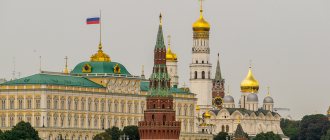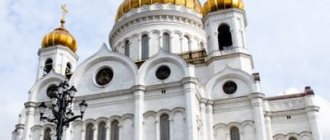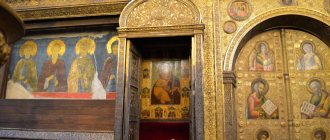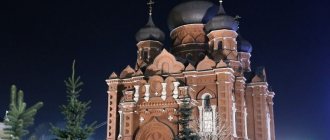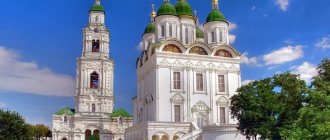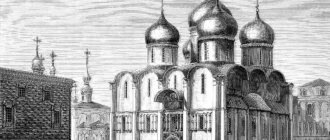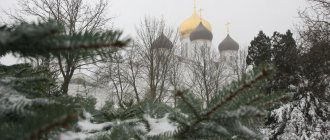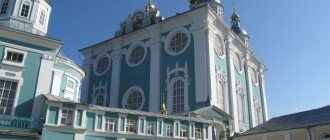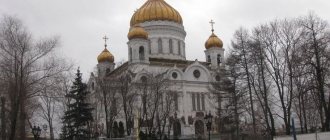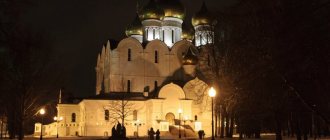"Save me, God!".
Thank you for visiting our website, before you start studying the information, please subscribe to our Orthodox community on Instagram, Lord, Save and Preserve † - https://www.instagram.com/spasi.gospodi/. The community has more than 60,000 subscribers. There are many of us like-minded people and we are growing quickly, we post prayers, sayings of saints, prayer requests, and timely post useful information about holidays and Orthodox events... Subscribe. Guardian Angel to you!
It has long been no secret that since time immemorial in Rus', Orthodox prayer houses were considered to be the starting points for the construction of cities themselves, since they were the basis of each of the settlements. Moreover, it was stated that the buildings should have been built precisely on those places where the holy relics of the saints, who actually personified the “heart of the city,” rested. For a populated area, the name of the righteous was used as a secret name. It is noteworthy that it was the Church of the Assumption of the Mother of God that became the first object during the birth of Moscow. From this article you can learn in more detail about how the Assumption Cathedral was built in Moscow, the schedule of services, and how you can get to it.
History of formation
The Assumption Cathedral became a symbol of the new Rus', which began to move from the second half of the 12th century to the North-East to the city of Vladimir, where Prince Andrei Bogolyubsky created a new center of life for the Russians, an alternative to Kyiv. During his time, the Assumption Church was erected in the city of Vladimir, the greatest masterpiece of pre-Mongol Rus'. In a way, it became the prototype of the future Assumption Cathedral in Moscow.
Cathedral of the Assumption of the Blessed Virgin Mary in the Kremlin, Moscow
But before such a temple appeared in Moscow, it was preceded by some events:
- the youngest son of Grand Duke Alexander Nevsky, Prince Daniil, receives the small city of Moscow and its environs as an inheritance;
- During his reign, Holy Prince Daniel was able to significantly expand the borders of his principality, annexing Kolomna and Pereslavl-Zalessky to the Moscow principality;
- the prince's children, Yuri and Ivan I Kalita, further expanded the borders of their principality, but above all, created the basis for the future of the Russian state.
It was under Prince Ivan Kalita that the first Assumption Cathedral in Moscow was built. It was originally associated with the name of St. Peter, who moved from Vladimir to Moscow at the invitation of Prince Ivan.
- Metropolitan Peter of Kiev moved from Vladimir to Moscow in 1325, where, at his insistence, a temple was founded in 1326, which was consecrated on August 4, 1827.
- Metropolitan Peter himself did not live to see the consecration, but was buried in the cathedral itself. Subsequently, three chapels were added to the temple: in 1329 in honor of the Adoration of the Honorable Chains of the Apostle Peter, the Praise of the Mother of God (1459) and in honor of St. Demetrius of Thessalonica.
- At the end of the 15th century, namely in 1474, they began to build a new cathedral. The construction was entrusted to the Pskov masters Myshkin and Krivtsov; the walls were almost built, but due to improper work, the Assumption Cathedral collapsed.
The wife of Grand Duke Ivan III, Sofia Paleolog, suggested that her husband invite a master from abroad. An ambassador was sent to Italy, who invited an experienced master, Aristotle Fioravanti.
Interesting fact! Fioravanti was not only a skilled architect, but also an engineer and gunsmith.
Before starting construction, he thoroughly studied the examples of Russian architecture of the pre-Mongol period, visiting Vladimir and other cities where stone churches were preserved. The temple was founded in 1475, and in August 1479 its consecration took place.
Gate icon of the Blessed Virgin Mary in the Assumption Cathedral
Important! It is probably not an accident that the next year after the foundation of the old Assumption Cathedral in 1326, the Moscow prince Ivan Kalita received a label for the great reign in the Horde, and from that moment the actual rise of Moscow began. And the next year after the consecration of the new cathedral in 1480, the Russian state was freed from the Mongol yoke.
After the October Revolution, the new authorities banned worship in Kremlin churches. The last service in the cathedral was held on Easter 1918. Since 1922, the Assumption Cathedral has become part of the Moscow Kremlin Museum, but it was opened to visitors only in 1955.
Construction of the Assumption Cathedral in Moscow
The original, but unfortunately not preserved, temple was made of stone on the site where there had previously been a wooden chapel and was erected in 1326-1327. during the time of Ivan I Kalita. The sanctuary itself was single-domed, three-apse, created in the image of the ancient St. George Church, preserved to this day in Yuryev-Polsky (Vladimir region).
The white-stone sanctuary, having already reached the middle of the 15th century, had a fairly large number of destructions, therefore, even under Ivan III, a decision was made to build a new monastery, which would be significantly larger in size than the old one.
From the very beginning, the construction work on the construction of the sanctuary in the Kremlin was entrusted to such masters as Myshkin and Krivtsov, but the construction of the prayer service according to their layout never reached the final stage, that is, the structure that they brought to the vaults was collapsed during an earthquake, happened in 1474
As a result of this event, the current Moscow pilgrimage was erected by Aristotle Fioravanti, an architect who built the sanctuary following the example of the majestic Assumption Church in Vladimir, built in the 12th century.
Must read: Annunciation Cathedral in Kharkov
The five-apse, five-domed chapel was consecrated in 1479. The frescoes of the cathedral sanctuary were painted in the period from 1482-1515. One of the icon painters involved in the construction of the temple, Dionysius, was truly a legendary creator of cathedral paintings, but alas, the frescoes he painted have survived to this day only in partial form.
Dear brothers and sisters! We invite you to visit the unique resource https://www.slovo-pomoshi.ru/. With its help, you can convey your aspirations to St. Petersburg churches, chapels, monasteries, and also contact the righteous at the place of their burial. We will write a note ourselves, take it to the temple and send you a photo report by email. Turning to God with the help of prayers has helped many people overcome grief, regain health and the joy of worldly life.
Useful articles:
If children are sick, you need to read Psalm 91 and the Lord’s Prayer seven times. If it’s something serious, read it. If children are sick, you need to read the 90th Psalm and the Lord’s Prayer seven times. If there is something serious, you need to read it twelve times... If a misfortune happens to a person, you need to read the 90th Psalm... If you have restless children, sick ones, then you need to read the prayer “Theotokos” forty times over those sleeping... Read more
God - we can’t scold! God - we can’t scold! Here are examples from life about people who dared to raise their dirty hands and filthy tongues against God and the Church. When a church was broken in the village of Selyavny, Voronezh region, the chairman of the village council and two of his assistants smashed a unique huge... Read more
TIPS - FRIENDS. HOW TO SAVE YOUR FAMILY. Hegumen Georgy (Shestun) A man should know: IT IS IMPOSSIBLE TO HUMILIATE and insult your wife by CALLING her rude words. Harsh words - WILL BE REMEMBERED, will land - A wound on the heart and will be expelled from there - Love. A man DOES NOT HAVE the right - TO COMMAND, to shout, to offend, and TO SUBMIT BY FORCE, by violence - his wife to himself. A man... Read more
“COMMANDMENTS” OF ANNA ROMASHKO, A MOTHER OF MANY CHILDREN 1) Do not complicate your life with many worries. 2) Love everyone who is around the children. Always thank those who help us raise and educate them. 3) Don’t be vain and vain, don’t chase success, don’t demand achievements from your child. 4) Teach yourself and your children to bring... Read more
The temple itself was able to survive, but during its considerable history it was damaged more than once in fires, but ultimately it was restored again and again, thereby preserving the main patriarchal chapel of the state, as well as the metropolitan and patriarchal necropolis.
During the years of Soviet power, the presented temple was closed for quite a long period to visiting Orthodox people, as well as other visitors, namely, the sanctuary did not function from 1918-1955, and after this time it again became effective, but as a museum. At the same time, worship services were restored only in 1990, but the status of a museum still remains with this building.
Description of the cathedral
The model for the temple was the Vladimir Assumption Cathedral. Aristotle Fioravanti was faced with the task of significantly expanding the internal space of the temple, as well as following the traditions of Russian architecture, which he succeeded in doing very well. The architectural elements of the temple are made as follows:
- externally, the cathedral looks like a single monolith, due to the fact that the white stones from which it is built are carefully adjusted to each other;
- the facade is divided into equal parts using blades;
- the low apses of the temple are covered with pylons;
- there are narrow windows on the walls;
- the entire building is crowned with a five-domed structure slightly shifted to the east.
Interior decoration of the Assumption Cathedral in Moscow
The Assumption Cathedral looks like a single whole, it seems that it was simply carved from one large white stone.
Interesting fact! To increase the internal volume, Aristotle Fioravanti used cross vaults in the design of the temple, the thickness of which is one brick, as well as metal connections inside the walls and openings. This was the first time such a solution was used in the history of Russian architecture.
How to get to the Assumption Cathedral of the Moscow Kremlin - contacts and opening hours
The Assumption Cathedral is located on the territory of the Kremlin. Therefore, you can only get into it through the Kremlin gates and pay the entrance fee. The cost of a ticket to the entire Kremlin territory is 350 rubles without discounts .
The complex is open from 9 a.m. to 4 p.m., and the temple itself from 10 a.m. to 5 p.m. Closed on Thursday. You can get to the temple by metro or bus.
You can contact representatives of the museum-reserve or organize a tour by calling 8 or 8 .
Also, all information about contacts and opening hours on holidays can be found on the website https://assumption-cathedral.kreml.ru/
Anyone can enter the temple wearing closed clothing, observing the appropriate rules of behavior in the temple.
Please note: photography and video shooting using flashes is not permitted. Only allowed outside the temple.
Road to the Assumption Monastery
You can get to the Assumption Cathedral like this:
If you go by car, the journey will take about five hours along the M7 highway. Having arrived in the southern outskirts of the city of Ivanovo, you should go either along the street. Lezhnevskaya, or on the street. Bubnova, and then from one of them turn onto Smirnova Street. This is where the Assumption Cathedral in Ivanovo is located.- By train from Yaroslavsky station from Moscow to Ivanovo you can get in 7 hours.
- Regular buses run from the Shchelkovskaya metro station in Moscow to Ivanovo; they can take you to your destination in 6 hours.
- In the city of Ivanovo, trolleybus 5 and bus 8 go to the monastery. The stop is called “Men’s Monastery”. When you get off at this stop, you will immediately see the Assumption Cathedral.
Divine services are held here daily: in the morning at 7:00 and in the evening at 16:20. The church shop is open to the public daily from 7:00 to 19:00 .
Cathedral of Ivanovo
Parish life
The Assumption Cathedral has an active social life.
There is a children's Sunday school, the Orthodox Volunteers movement has been organized, whose members provide assistance to boarding schools and nursing homes, take part in festivals and organize charity fairs, and work in monasteries and dioceses.
The church also has a sobriety society, which employs Orthodox specialists who help addicted people and their relatives cope with their illness.
Restoration and restoration of the cathedral
The fresh wind of perestroika had long swept over Russia, and the government, with concrete deeds, confirmed its new approach to issues related to religion, and Ivanovo electricians stubbornly continued to hold on to their premises. Only in 2003 were they able to force them to release him. By this time, by order of the Holy Synod, a monastery was opened on the territory of the former cemetery, and the temple thus ended up in its possession.
However, there was still a lot of work ahead. The cathedral was returned to the believers in terrible condition. Restoration and restoration work began in 2007 and was carried out not only with funds allocated by the Patriarchate, but also with voluntary donations from citizens - residents of Ivanovo and other cities of Russia. When their main part was completed, it was decided to give the temple the status of a city cathedral.
Generous philanthropist
A year after the start of work, Nikolai Stepanovich Shodchin died, but his work was continued by his son and heir, Anton Nikolaevich. This man was a bright and extraordinary personality. Having continued and developed his father's business, he managed to amass a multimillion-dollar fortune, constantly donating money to numerous homeless shelters, hospitals and almshouses.
A curious detail - few people know that the Orthodox St. Nicholas Cathedral on 97th Street in New York was built precisely with the money of the Ivanovo peasant Anton Nikolaevich Shodchin, who expressed his will in his will and allocated the necessary funds.
Photos
Photos of the Assumption Cathedral in Ivanovo can be found in guidebooks, as well as on various specialized websites. There are interesting photos telling about the stages of restoration of the temple, modern views of the Cathedral, as well as images of the interior decoration and wall paintings.
History[edit]
In the southeast of modern Ivanovo, from the beginning of the 18th century, there was the Assumption Pogost. In 1815, monks from the Intercession Monastery, with the permission of Archimandrite Xenophon, moved a wooden church to this old cemetery. And five years later, a bell tower was built at the old church, the design of which, made in the traditions of mature classicism, was prepared by the provincial architect Evgraf Yakovlevich Petrov.
However, time passed, and the wooden church grew old and collapsed. Therefore E.Ya. Petrov created a project for a new brick church. The expensive stone construction was sponsored by Ivanovo-Voznesensk industrialists - Nikolai Stepanovich Shodchin and Kosma Ivanovich Butrimov. Large-scale construction work lasted for 9 years. The building was completed with the money of Anton Nikolaevich Shodchin. The cemetery church was finally ready by the fall of 1843, and Archimandrite Polycarp consecrated it.
The facades of the temple were decorated in the spirit of classicism, and several ancient icons were transferred here from the old wooden church. It is interesting that for all iconographic images, benefactors ordered frames made of forged silver with gilding. In the 70-80s of the 19th century, a refectory was added to the temple and connected to the bell tower building.
In the early 20s of the last century, the young Soviet state carried out mass seizures of expensive church utensils from Orthodox churches. The Assumption Church was no exception, and 288 kg of silver items were removed from it, many of which were of great historical and artistic value. Later, in 1924, Ivanovo authorities described the personal belongings of church warden Nikolai Terentyevich Shchapov and accused him of hiding valuables from requisition. Under this pretext, the lease agreement with the Orthodox community was not renewed, and the religious building was transferred to the local branch of the renovationists, the so-called “Living Church.”
The dark streak in the history of the temple did not end there. In 1933, when the Soviet state was actively fighting religion, the Assumption Church was closed and the old churchyard was razed to the ground. At the same time, tombstones were used to make road curbs. On the former cemetery land, the Melange Plant laid out its park of culture and recreation and built a dance floor, a reading room and a summer cinema under the telling name “Balagan” on the former graves. Although the place was given over to public entertainment, the townspeople remembered its history and began to call the cultural park “the park of the living and the dead.”
Since 1933, a dormitory was made in the church and even in its altar, in which about 180 people (49 families) lived. Over the next few decades, the temple continued to deteriorate, and its interior was completely destroyed. And although the main volume of the religious building was preserved well, in the middle of the last century the church domes and side porticos were completely demolished. And from the temple bell tower, only the lower tier was left and a shower room was installed in this room. Since 1950, the rebuilt church building has been used by Ivgoreletroset, an enterprise that services electrical communications in Ivanovo.
The Assumption Church was one of seven in Ivanovo that survived the years of Soviet power. And it became the last of the old churches that the state returned to believers. In 1992, an initiative group of Christians registered the Assumption Parish, and three years later services were resumed here.
By decree of the Ivanovo Archbishop, the church initially received the status of a temple under the monastic community. Then in the spring of 1998, after the restoration, by order of Patriarch Alexy, the Dormition Monastery was opened.
Shrines
From 1395 until the October Revolution, the Assumption Cathedral housed the main shrine of pre-Mongol Rus', the Vladimir Icon of the Mother of God. Nowadays this icon is in the church in honor of St. Nicholas the Wonderworker in Tolmachi, which is the home church of the Tretyakov Gallery.
Interesting! According to legend, the icon always chose the place where it should be located, now it is a small temple in Moscow.
Of those shrines that are now in the cathedral, the following icons have been preserved:
Mother of God "Blachernae". According to legend, it was written by the Evangelist Luke and came from Antioch to Constantinople, and in 1653 it was donated to the Russian Tsar Alexei Mikhailovich. The icon itself is made using the wax-mastic technique, i.e. it is, as it were, in relief, and wax with particles of the relics of many saints was used as mastic; Petrine Icon of the Mother of God. It is believed that it was written by Metropolitan Peter himself when he was still abbot in Volyn; he gave it to Metropolitan Maxim of Kyiv, who brought the icon to Vladimir, and then it ended up in Moscow; Korsun Icon of the Mother of God. Tradition claims that the icon was painted by the Evangelist Luke from the Mother of God herself, and the copy of this icon was transferred to Korsun during the Baptism of Prince Vladimir. Initially it was located in Novgorod, and then was moved to Moscow.
Also the relics of the Moscow saints:
Peter; Theognostus; Cyprian; Photius; Jonah; Philip II. Divine service in the Assumption Cathedral of the Moscow Kremlin
The holy relics of the first Russian Patriarch Job, as well as the holy Patriarch Hermogenes. In addition, the Assumption Cathedral houses such relics of the Christian world as the Nail of the Lord and the staff of St. Metropolitan Peter of Moscow.
Unique wall paintings and iconostasis of the 17th Cathedral with numerous world-famous icons, including: “The Ardent Eye of the Savior,” “The Savior in Power,” “The Golden Haired Savior.”
